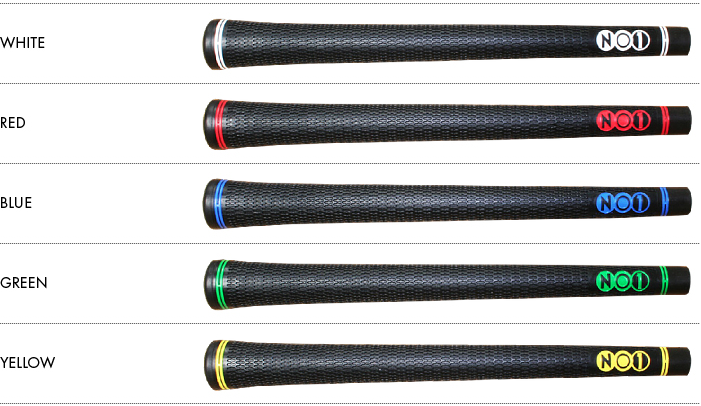- HOME・ホーム
-
日本語
-
About Tom Fielding Golfについて
- Teaching Philosophy
- Privacy Policy
- Tom Fielding Golf School Japan - Golf Improvement BLOG
-
Blog and News Updates
>
- How good a golfer are you right now
- How Far Should I Hit My 7 Iron?
- Most Golf Fitness Misses the Mark Completely
- The Mid Round Slump!
- Take This Quick Strike Test To See What Level You Are
- Golf Camps・ゴルフ合宿
- 2019 Summer Golf camp photo galleries
- JP-3 day / 2 night: Golf Camp 3日・2泊ゴルフ合宿
- EN-3 day / 2 night: Golf Camp
- APRIL/MAY2019 Newsletter: EN version
- February 2019 Newsletter: EN version
- February 2019 Newsletter: JP version
- Golf Fitness
- Why is change so difficult
-
Lesson Articles
>
- How To Practice Golf At Home – 6 Steps To Practicing At Home
- Internal & External focus - JP
- Pro Golfers are not that good
- 3 essentials for CONSISTENCY IN GOLF
- The Golf Swing and negative words
- Beat the Heat
- Hot Weather Guidelines
- Swing Radius
- Exclusive 4 steps for improved ball striking
- Hitting from different lies
- Weight transference
- POSTURE
- Training in different climates
- Fitness Friday: Preparing for a cold-weather round
- How far will the golf ball go in cold weather
- TrackMan: Definitive Answers at Impact and More
- Clearing the left side too early is damaging.
- The Ball Flight Laws
- Head Position
- Distance = Club Head Speed + Square Impact + launch angle
- Attention! The Pre-Shot Routine
- The Basic Skill of Chipping
- 4 stages of learning
- How to Break 90 - Part 1
- How to Break 90 #2
- How to Learn a Great Golf Swing
- Perfect Practise makes practise.
- 3 Essentials to breaking a habit
- Basic principles of exercise - Points to bring out the maximum practicing effect
- Things to consider before aiming at the flagstick
- Learnig motor skills: The GOLF Swing
- RULES OF GOLF PAGE >
- Golf Humour >
-
ゴルフスクール Menu
- 2024 SUMMER Golf Camp in Japan-EN >
- 2024SGC-JP サマーゴルフ
- Melbourne Golf Tour: March 2025
- Teaching locations: Lessons inquires & bookings >
- Trial Golf Lesson >
- 2 hole Private・貸切 training program
- 1/2 day Golf School: Kashikiri program@Morinagatakako CC
- Internet Golf Lesson >
- Testimonials Customer feedback
-
Photo / Video Gallery
- 2023 Summer gof camp photo gallery
- 2022 Summer Golf Camp - Photo Gallery
- 1 / 2 day golf camp - Photo gallery
- 2021 Summer Golf Camp - photo gallery
- 2020 Summer golf camp@ Appi Kogen Iwate prefecture
- 2019 Summer Golf camp photo gallery
- Summer golf camp 2018 photo gallery
- Photo Gallery from the Australia Vs Japan Junior challenge
- 2017 5周年のSummer golf camp-Photo/Video gallery
- 2016 4周年のSummer Golf Camp Photo Gallery
- 2015 The 3rd Summer Golf Camp @ Pelican Waters Golf Resort
- 2014 Summer Golf camp photo gallery
- 2013 Summer Golf Camp at Pelican Waters, Sunshine Coast, Queensland Australia.
- 2014 The 3rd Students Cup Pro-Am 2014 - Photo Gallery
- 2013 The 2nd Students Cup Pro-Am 2013
- Video Gallery
How to hit from undulating lies.
The big problem for golfers is coping with the never ending variation of undulating lies that they will experience during a regular game of golf.
However for most golfers the main portion of their practice time is carried out on a flat surface, therefore in general terms the golfer is adapting their technique (stance, club length, swing pattern etc.) only to suit a flat lie.
However during any regular game of golf the golfer will be faced with a great variety of different lies due the natural undulation of the golf course, in some cases these undulations can be quite severe. As we all know there are actually not too many totally flat golf courses.
Therefore I would like to offer some general recommendations that with a little nit a practice, will help to you to overcome these situations so that at the very least you will be able to make good impact with the ball, and thereby increasing your combat skills, so giving you greater chances of conquering the variety of challenges that all golfers will experience during a regular game of golf.
Important to note that a good routine will enable you to make the best setup possible setup to suit each situation that you will encounter.
However there are will always be occasions when we will be faced with quite severe undulations, so in order to overcome these challenging conditions, please consider the following suggestions when making starting your routine for your set up position.
The big problem for golfers is coping with the never ending variation of undulating lies that they will experience during a regular game of golf.
However for most golfers the main portion of their practice time is carried out on a flat surface, therefore in general terms the golfer is adapting their technique (stance, club length, swing pattern etc.) only to suit a flat lie.
However during any regular game of golf the golfer will be faced with a great variety of different lies due the natural undulation of the golf course, in some cases these undulations can be quite severe. As we all know there are actually not too many totally flat golf courses.
Therefore I would like to offer some general recommendations that with a little nit a practice, will help to you to overcome these situations so that at the very least you will be able to make good impact with the ball, and thereby increasing your combat skills, so giving you greater chances of conquering the variety of challenges that all golfers will experience during a regular game of golf.
Important to note that a good routine will enable you to make the best setup possible setup to suit each situation that you will encounter.
However there are will always be occasions when we will be faced with quite severe undulations, so in order to overcome these challenging conditions, please consider the following suggestions when making starting your routine for your set up position.
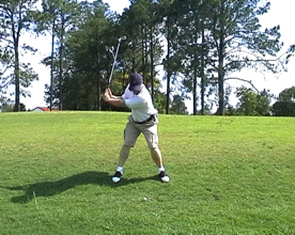
1.Ball below feet- side hill(photo #1- ball below feet)
When the ball is below your feet you will sense that the ball’s position is somewhat further away than when you hit from usually experience when hitting from a flat ground. To counter this I suggest that you widen your stancesufficiently so that you can reestablish the distance between you and the ball (as it is when hitting from a regular flat lie).
Ball flight tendencies from this lie are;
When the ball is below your feet you will sense that the ball’s position is somewhat further away than when you hit from usually experience when hitting from a flat ground. To counter this I suggest that you widen your stancesufficiently so that you can reestablish the distance between you and the ball (as it is when hitting from a regular flat lie).
Ball flight tendencies from this lie are;
- Slice
- Expect a loss of your regular distance achieved by the club you use, due to the restricted swing
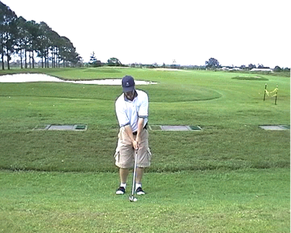
2.Ball above feet- side hill(photo #2- ball below feet)
In this case the ball will feel closer to you so to counter this I suggest that you narrow your stanceso as to reestablish the regular distance between you and the ball.
Ball flight tendencies from this lie are;
Hook
In this case the ball will feel closer to you so to counter this I suggest that you narrow your stanceso as to reestablish the regular distance between you and the ball.
Ball flight tendencies from this lie are;
Hook
- Expect a loss of your regular distance achieved by the club you use, due to the restricted swing
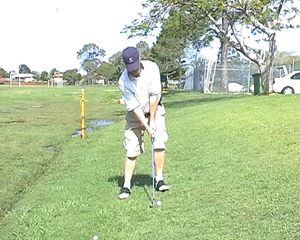
3Ball positioned on up slope- (uphill lie) (photo #3- Upslope)
For an uphill lie, in general terms you will need to position the tilt in your body more away from the target, this will then require you to have you’re your weight more on your back leg than usual. Once you have established the stance to suit the angle of the slope, you must maintain balanced on your back foot until impact.
As for the ball position in your stance, generally slightly further forward in your stance, however the most suitable spot will be influenced by the individual’s peculiar swing habits and as everybody has developed their your own characteristics, then it is advisable to as first have a few practice swings in a location that is similar to that of the ball’s current position, and monitor where the club head regularly first strikes the ground, and if you remember its relative position to your stance, then you can make the subtle adjustments to your final set up to suit you.
Ball flight tendencies from this lie are;
For an uphill lie, in general terms you will need to position the tilt in your body more away from the target, this will then require you to have you’re your weight more on your back leg than usual. Once you have established the stance to suit the angle of the slope, you must maintain balanced on your back foot until impact.
As for the ball position in your stance, generally slightly further forward in your stance, however the most suitable spot will be influenced by the individual’s peculiar swing habits and as everybody has developed their your own characteristics, then it is advisable to as first have a few practice swings in a location that is similar to that of the ball’s current position, and monitor where the club head regularly first strikes the ground, and if you remember its relative position to your stance, then you can make the subtle adjustments to your final set up to suit you.
Ball flight tendencies from this lie are;
- High than usual ball flight brought about by the increase in relative loft. So if you think to hit a 7, use a 5 instead. Be aware of wind!
- Expect a loss of your regular distance achieved by the club you use, due to the restricted swing & extra high ball flight
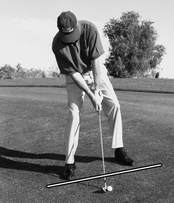
The ball needs to go uphill: Because your left leg is higher than your right, your weight naturally shifts to your right leg. Let that weight shift happen so your shoulders are parallel to the slope of the hill.
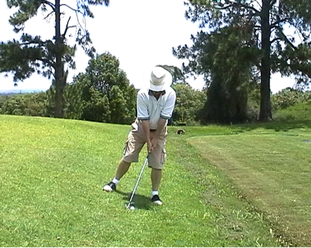
4Ball positioned on a down slope-(downhill lie)(photo #4-downslope)
For a downhill lie, you are required to adjust your set up so that you are positioned towards the target; this will mean that your weight will be balanced mainly on your front foot. Once you have established the stance to suit the angle of the slope, you must maintain balanced on your Front foot until impact.
As for the ball position in your stance, generally slightly further back in your stance, however the most suitable spot will be influenced by the individual’s peculiar swing habits and as everybody has developed their your own characteristics, then it is advisable to as first have a few practice swings in a location that is similar to that of the ball’s current position, and monitor where the club head regularly first strikes the ground, and if you remember its relative position to your stance, then you can make the subtle adjustments to your final set up to suit you.
Ball flight tendencies from this lie are;
For a downhill lie, you are required to adjust your set up so that you are positioned towards the target; this will mean that your weight will be balanced mainly on your front foot. Once you have established the stance to suit the angle of the slope, you must maintain balanced on your Front foot until impact.
As for the ball position in your stance, generally slightly further back in your stance, however the most suitable spot will be influenced by the individual’s peculiar swing habits and as everybody has developed their your own characteristics, then it is advisable to as first have a few practice swings in a location that is similar to that of the ball’s current position, and monitor where the club head regularly first strikes the ground, and if you remember its relative position to your stance, then you can make the subtle adjustments to your final set up to suit you.
Ball flight tendencies from this lie are;
- Lower than usual ball flight brought about by the decrease in relative loft. So if you think to hit a 7, use a 9 instead.
- Expect a loss of your regular distance achieved by the club you use, due to the restricted swing & the quite low ball flight.
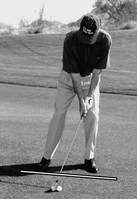
The ball needs to go downhill: On a downslope, your weight shifts in the opposite direction, onto your left leg. Again, let that weight shift happen. Keep your shoulders and the banister parallel.
Finally, follow these three rules:
- Adjust your aim when you’re on a slope. Off a downslope or when the ball is below your feet, aim to the left of where you want the ball to finish. Off an upslope or when the ball is above your feet, aim right.
- Factor in ball position. Play the ball back toward the middle of your stance if you’re on a downhill lie or forward, off your left big toe, from an uphill lie.
- Use the right club. Take more club (a club that has less loft) if you’re on an uphill lie because the ball tends to fly higher. Use less club (a club that has more loft) from a downhill lie because the ball has a lower trajectory.
NOTE:
When dealing with any of the above mentioned conditions, it is strongly recommended that you understand the relative angle between the spine and the ground. When making your stance on a flat ground your spine is not perpendicular to the ground the top part is in fact slightly tilted away from the target, for a right hander this means that the spine is slightly tilted to the golfer’s right. Opposite for left handers.
So when confronted will undulating lies in order to make a solid and clean impact with the ball with out chopping into the ground (digging a deep divot), or topping the ball. It is very important that we learn how to adjust our set up so that our spine angle and set up position is set in the most appropriate to correspond as close as possible to that of the angle of the slope that the ball will be hit from.
On top of that to ensure even greater success, I advise to you adopt a one or two practice swings on a similar lie to the one you face, and monitor where the club head first strikes the ground. This in effect will help you search and find the most appropriate ball position for each and every angle of undulation that you will face while playing golf
When dealing with any of the above mentioned conditions, it is strongly recommended that you understand the relative angle between the spine and the ground. When making your stance on a flat ground your spine is not perpendicular to the ground the top part is in fact slightly tilted away from the target, for a right hander this means that the spine is slightly tilted to the golfer’s right. Opposite for left handers.
So when confronted will undulating lies in order to make a solid and clean impact with the ball with out chopping into the ground (digging a deep divot), or topping the ball. It is very important that we learn how to adjust our set up so that our spine angle and set up position is set in the most appropriate to correspond as close as possible to that of the angle of the slope that the ball will be hit from.
On top of that to ensure even greater success, I advise to you adopt a one or two practice swings on a similar lie to the one you face, and monitor where the club head first strikes the ground. This in effect will help you search and find the most appropriate ball position for each and every angle of undulation that you will face while playing golf

Your Golfers Guide,
Tom Fielding
- HOME・ホーム
-
日本語
-
About Tom Fielding Golfについて
- Teaching Philosophy
- Privacy Policy
- Tom Fielding Golf School Japan - Golf Improvement BLOG
-
Blog and News Updates
>
- How good a golfer are you right now
- How Far Should I Hit My 7 Iron?
- Most Golf Fitness Misses the Mark Completely
- The Mid Round Slump!
- Take This Quick Strike Test To See What Level You Are
- Golf Camps・ゴルフ合宿
- 2019 Summer Golf camp photo galleries
- JP-3 day / 2 night: Golf Camp 3日・2泊ゴルフ合宿
- EN-3 day / 2 night: Golf Camp
- APRIL/MAY2019 Newsletter: EN version
- February 2019 Newsletter: EN version
- February 2019 Newsletter: JP version
- Golf Fitness
- Why is change so difficult
-
Lesson Articles
>
- How To Practice Golf At Home – 6 Steps To Practicing At Home
- Internal & External focus - JP
- Pro Golfers are not that good
- 3 essentials for CONSISTENCY IN GOLF
- The Golf Swing and negative words
- Beat the Heat
- Hot Weather Guidelines
- Swing Radius
- Exclusive 4 steps for improved ball striking
- Hitting from different lies
- Weight transference
- POSTURE
- Training in different climates
- Fitness Friday: Preparing for a cold-weather round
- How far will the golf ball go in cold weather
- TrackMan: Definitive Answers at Impact and More
- Clearing the left side too early is damaging.
- The Ball Flight Laws
- Head Position
- Distance = Club Head Speed + Square Impact + launch angle
- Attention! The Pre-Shot Routine
- The Basic Skill of Chipping
- 4 stages of learning
- How to Break 90 - Part 1
- How to Break 90 #2
- How to Learn a Great Golf Swing
- Perfect Practise makes practise.
- 3 Essentials to breaking a habit
- Basic principles of exercise - Points to bring out the maximum practicing effect
- Things to consider before aiming at the flagstick
- Learnig motor skills: The GOLF Swing
- RULES OF GOLF PAGE >
- Golf Humour >
-
ゴルフスクール Menu
- 2024 SUMMER Golf Camp in Japan-EN >
- 2024SGC-JP サマーゴルフ
- Melbourne Golf Tour: March 2025
- Teaching locations: Lessons inquires & bookings >
- Trial Golf Lesson >
- 2 hole Private・貸切 training program
- 1/2 day Golf School: Kashikiri program@Morinagatakako CC
- Internet Golf Lesson >
- Testimonials Customer feedback
-
Photo / Video Gallery
- 2023 Summer gof camp photo gallery
- 2022 Summer Golf Camp - Photo Gallery
- 1 / 2 day golf camp - Photo gallery
- 2021 Summer Golf Camp - photo gallery
- 2020 Summer golf camp@ Appi Kogen Iwate prefecture
- 2019 Summer Golf camp photo gallery
- Summer golf camp 2018 photo gallery
- Photo Gallery from the Australia Vs Japan Junior challenge
- 2017 5周年のSummer golf camp-Photo/Video gallery
- 2016 4周年のSummer Golf Camp Photo Gallery
- 2015 The 3rd Summer Golf Camp @ Pelican Waters Golf Resort
- 2014 Summer Golf camp photo gallery
- 2013 Summer Golf Camp at Pelican Waters, Sunshine Coast, Queensland Australia.
- 2014 The 3rd Students Cup Pro-Am 2014 - Photo Gallery
- 2013 The 2nd Students Cup Pro-Am 2013
- Video Gallery

